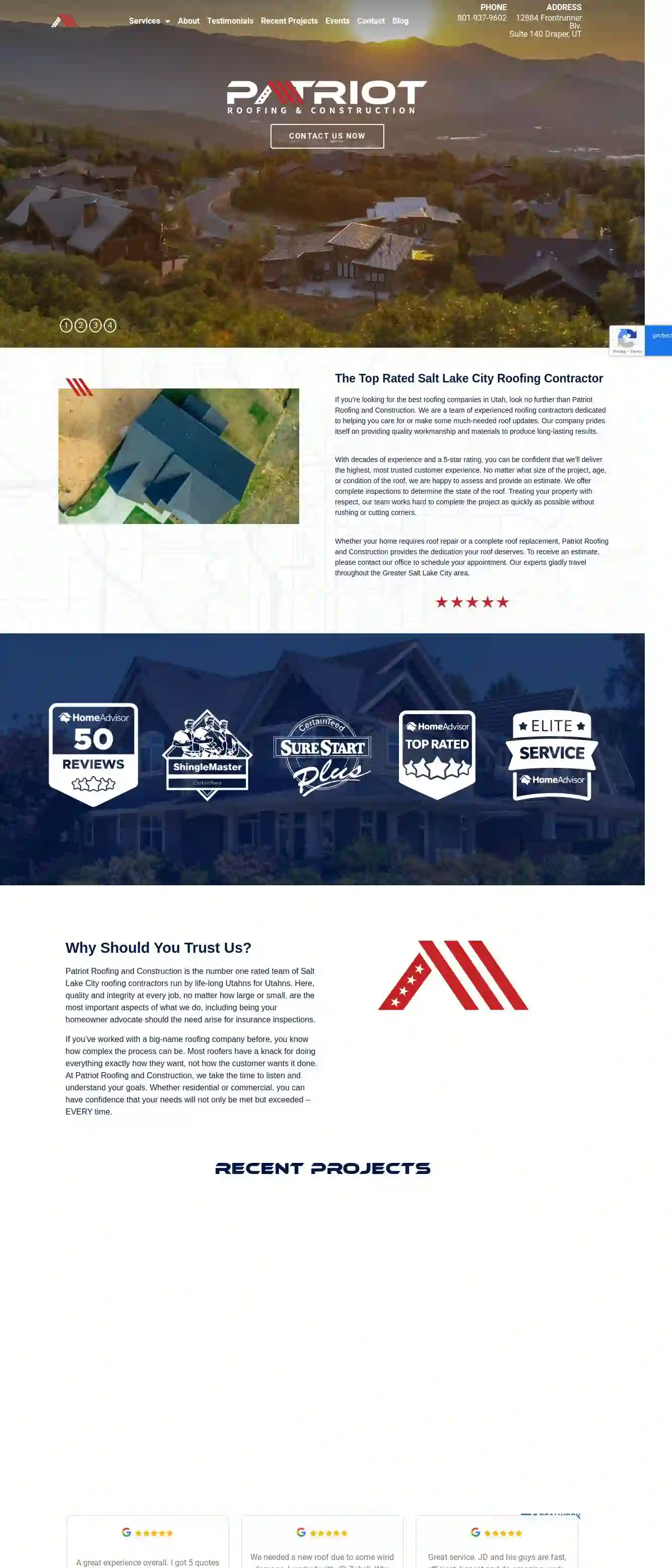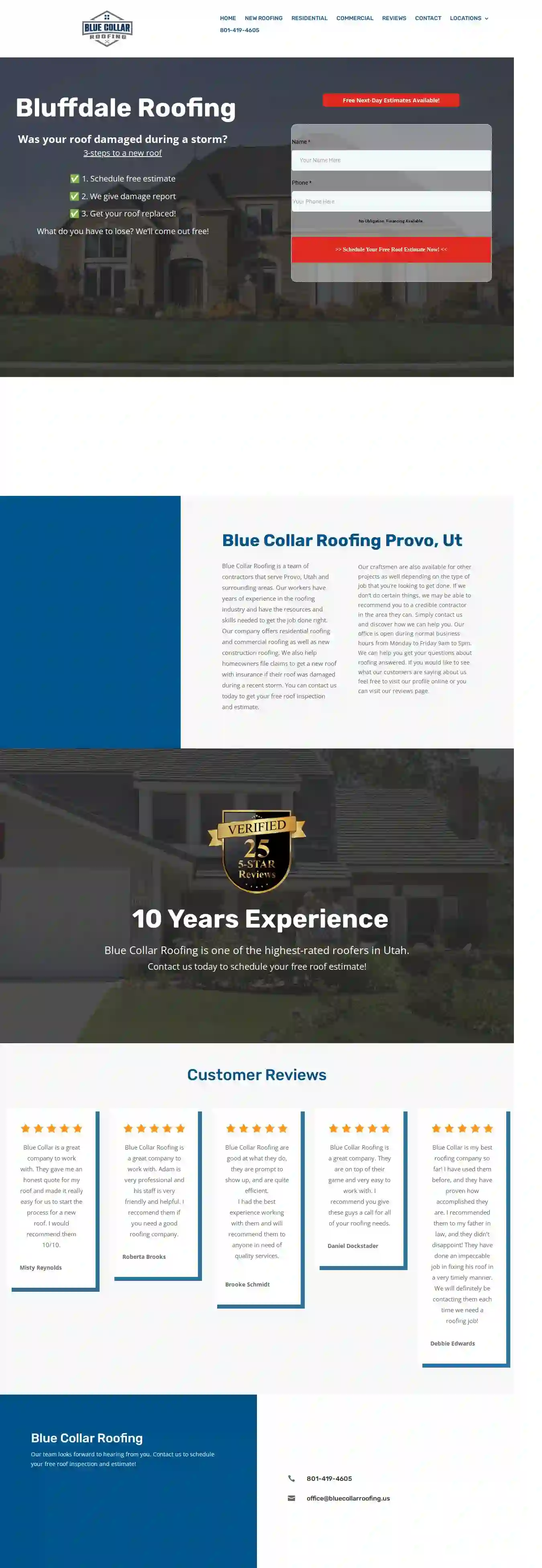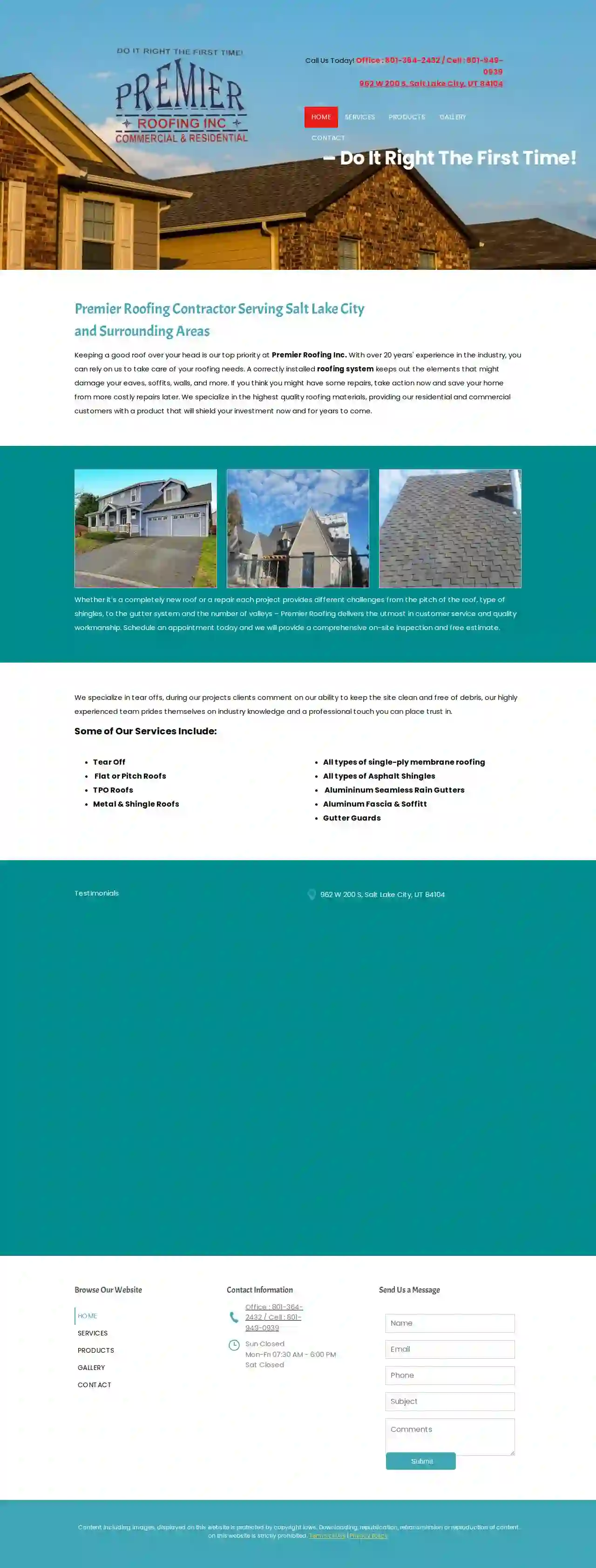Roofing Companies Layton
Best Roofing Service in Layton
Get up to 3 Roofing Contractor quotes for your project today! Compare profiles, reviews, accreditations, portfolio, etc... and choose the best offer.

Patriot Roofing & Construction
4.7136 reviewsSuite 140, 12884 Frontrunner Blv., Draper, 84020, USAs a disabled veteran-owned company, owner Eric Pauly takes great pride in the services provided by Patriot Roofing and Construction. From advocating for homeowners with insurance provider claims to providing the highest quality roof replacement in the Salt Lake City region, we strive to build long-lasting relationships that our customers are happy to refer to their friends and family. With past projects ranging from $500 in roof repairs to $4.2MM for structural rebuilds, our team has gained unrivaled experience with all types of roof system solutions in various environments. Regardless of the project size, we deliver quality workmanship in the quickest amount of time possible – without cutting corners or rushing the job. Unlike other big-name or seasoned roofing contractors that complete projects how they feel is best, our professionals recognize the importance of knowing your needs. By taking the time to listen and understand the goals, we ensure your expectations are exceeded. This isn’t just doing the work and clock out type of job for us. Instead, our family promises that you know exactly what to expect. We take the time to fully explain how a custom solution will meet your needs and answer all questions along the way. We have seen the adverse effects that unresponsive or sloppy contractors have left on the roofing industry. At Patriot Roofing and Construction, we believe in backing our words with actions and consistently delivering the highest quality result.
- Services
- Why Us?
- Testimonials
- Gallery
Get Quote
Salt Lake City Roofing
518 reviewsSalt Lake City, USUtah's Roofing is a respected roofer with over 25 years of experience in Salt Lake County, Utah. As a licensed contractor, we provide expert roofing repair, re-roofing, new construction roofs, and more for both residential and commercial customers. We specialize in new construction, re-roofing, flat, and more. Our team of licensed and insured roofers are dedicated to providing the best residential services to the Salt Lake Valley. We provide services in Park City, Heber, Davis County, Bountiful, Sandy, and Draper, Utah, to name a few. We do metal, wood, asphalt shingles, and TPO roofs. Our goal is to make your project as stress-free as possible, from the beginning to the end. We want to help ensure you have a quality roof over your head. With materials, you also get a manufacturer limited lifetime warranty. With our residential company, we bring each roof's individuality to life. We can handle any roofing project, whether it's a complete tear-off and replacement or simple repairs.
- Services
- Why Us?
- Testimonials
- Gallery
Get Quote
Roofing Salt Lake City
52 reviews123 Main Street, Suite 100, Salt Lake City, 84101, USRoofing Salt Lake City is a team of skilled roofers that have all of the essential certifications, years of expertise, and insurance coverage for premium roofing requirements. Roofing Salt Lake City has been in business for many years. Every single one of our customers can be certain that they will get solutions that are not only effective but also affordably priced, in addition to obtaining prompt services. When you have our crew working alongside you, you won't ever need to worry about the efficiency with which your roofing operations are being completed since they will be done to your satisfaction. Our ServicesEvery roof-related action we do is done with the objective of providing excellent service and assisting in the protection of your property. Our 24-hour emergency services include skilled roofing repairs to help you avoid more costly restoration work. Your and your family's safety is dependent on the quality of your roof, and we will not accept anything less than the best repair and replacement service available. Our experienced roofing services include roof repairs, replacements, and any commercial and residential roofing requirements. Our crew can handle anything from metal roofs to flat roofs.
- Services
- Why Us?
- Gallery
Get Quote
We Do Roofing Salt Lake City
4.9124 reviewsSalt Lake City, USWe Do Roofing Salt Lake City is a respected roofer in Salt Lake County Utah with over 20 years of experience. At We Do Roofing Salt Lake City we are a licensed roofing contractor that provides expert roof repairs, re-roofing, new construction roofs, as well as roofing repairs for both residential and commercial customers. We offer a wide range of roofing services from minor repairs to new residential home installations as well as large commercial real estate projects.
- Services
- Why Us?
- Testimonials
- Gallery
Get Quote
Blue Collar Roofing Provo
54 reviewsProvo, USBlue Collar Roofing is a team of contractors that serve South Jordan, Utah and surrounding areas. Our workers have years of experience in the roofing industry and have the resources and skills needed to get the job done right. Our company offers residential roofing and commercial roofing as well as new construction roofing. We also help homeowners file claims to get a new roof with insurance if their roof was damaged during a recent storm. You can contact us today to get your free roof inspection and estimate. Our craftsmen are also available for other projects as well depending on the type of job that you’re looking to get done. If we don’t do certain things, we may be able to recommend you to a credible contractor in the area they can. Simply contact us and discover how we can help you. Our office is open during normal business hours from Monday to Friday 9am to 5pm. We can help you get your questions about roofing answered. If you would like to see what our customers are saying about us feel free to visit our profile online or you can visit our reviews page.
- Services
- Why Us?
- Testimonials
- Gallery
Get Quote
Pioneer Roofing Co
4.792 reviewsSalt Lake City, USUtah’s Premier Commercial & Residential Roofing Contractor We are a team of experienced and expert roofing professionals who provide the highest quality roofing services to homeowners and businesses in Salt Lake City and throughout the state of Utah. We value our customers and provide exceptional customer service from start to finish. We are 100% transparent with all of our roofing quotes and work with each customer to understand their needs and provide the best solution for their roofing projects. We work diligently to ensure a professional experience is delivered consistently on each of our projects. We are committed to our core values of integrity in our work, attention to detail, and completing projects in a timely manner. On-Time Service Our advanced equipment and skilled crew allow us to get projects done on or ahead of schedule. 40+ Years Experience Founded in 1980, we are one of Utah’s most skilled and experienced roofers with expertise in all roofing types. Fair Pricing We provide fair and honest quotes to all of our customers. Our Latest Projects A selection of our latest roof designs, projects, & roofing remodels Cottonwood Heights Rec Center TPO Commercial Warehouse TPO Apartment Buildings View More Projects What We Do With over 40 years in the roofing industry, we have the knowledge and expertise to handle any commercial or residential project. Regardless of the size, we are equipped to handle all your roofing needs. We specialize in roof removal, disposal, cleanup, and installation of pitched and flat roofs. We work with asphalt shingles, TPO, PVC, and metal roofs. Weather in Utah is often extreme, so we strictly follow all state codes and requirements on every job we complete. Our dedication to excellence has made us one of Utah’s most trusted roofing companies. We work in Salt Lake, along the Wasatch Front and throughout the state of Utah. Call us today to get a quote on your upcoming project.
- Services
- Why Us?
- Testimonials
- Gallery
Get Quote
Roofing & Restoration by Romney
55 reviewsSalt Lake City, USHello! I am Travis, the founder of Roofing and Restoration by Romney. I have been in the Roofing and Restoration industry for seven years. Prior to working in the Roofing and Restoration industry, I worked with several different insurance companies. I am a general contractor, which allows me to work directly on homeowners roofs. Because of my prior experience with working with insurance agencies, I am also able to give estimates. I am able to give homeowners an estimate if insurance isn’t an option, but my primary goal is to work directly with insurance agencies and get on the same page on what a fair evaluation and estimate should be. My goal is to bridge the gap between homeowners and insurance companies so the process of making a claim has proper expectations. Roofing and Restoration by Romney is focused on providing industry expertise in both roofing and insurance. I am a licensed general contractor, whose goal is to work with insurance agents and adjusters to help with roofing reconstruction from wind, hail, water, and mold. My past experience within the insurance industry allows me to better understand the claim process to make it as smooth as possible.
- Services
- Why Us?
- Our Team
- Testimonials
- Gallery
Get Quote
Utah Roofing Company
720 E 1500 N, Ogden, 84404, USUtah Roofing Company operates under Profile Roofing. We service the entire Northern Utah area, from North Salt Lake City to Ogden Utah. Give us a call or request a free estimate on our website! Ogden Service Area 801-921-6815, Clinton Service Area 801-609-9740, Syracuse Service Area 801-845-4915. We specialize in new roofing, roof repairs, and roof inspections. Our goal is to offer fair and honest service for any roofing service need: New Roofing, Repairs, Inspections, Etc. Trust Profile Roofing with all your roofing projects. We promise you won’t find anyone else who does a flawless job and delivers your roofing services on time and gives you the 5-star experience you deserve!
- Services
- Why Us?
- Gallery
Get Quote
Premier Roofing Inc
3.69 reviews962 W 200 S, Salt Lake City, 84104, USPremier Roofing Contractor Serving Salt Lake City and Surrounding Areas Keeping a good roof over your head is our top priority at Premier Roofing Inc. With over 20 years' experience in the industry, you can rely on us to take care of your roofing needs. A correctly installed roofing system keeps out the elements that might damage your eaves, soffits, walls, and more. If you think you might have some repairs, take action now and save your home from more costly repairs later. We specialize in the highest quality roofing materials, providing our residential and commercial customers with a product that will shield your investment now and for years to come. Whether it's a completely new roof or a repair each project provides different challenges from the pitch of the roof, type of shingles, to the gutter system and the number of valleys – Premier Roofing delivers the utmost in customer service and quality workmanship. Schedule an appointment today and we will provide a comprehensive on-site inspection and free estimate. We specialize in tear offs, during our projects clients comment on our ability to keep the site clean and free of debris, our highly experienced team prides themselves on industry knowledge and a professional touch you can place trust in.
- Services
- Why Us?
- Testimonials
- Gallery
Get Quote
Veteran Roofing
59 reviewsProvo, USVeteran Roofing serves as a leading General Contractor Company in the Utah County area. We’re a team of fully-certified professionals who tackle everything from complex large projects to smaller-scale jobs. Fueled by our commitment to excellence, we go the extra mile to make sure clients are completely satisfied with our work.
- Services
- Why Us?
- Gallery
Get Quote
Over 17,196+ Roofers in our network
Our roofing contractors operate in Layton and beyond!
Roofyng.com has curated and vetted the Best Roofing Businesses in and around Layton. Find the most trustworthy pro today.
Frequently Asked Questions About Roofing Companies
- Metal roofs: Reflect sunlight, reducing cooling costs.
- Tile roofs: Offer thermal mass, regulating temperature.
- Cool roofs: White or light-colored roofs with high solar reflectance.
- Green roofs: Vegetated roofs providing insulation and reducing heat absorption.
- Asphalt Shingles: 20-30 years
- Metal Roofing: 40-70 years
- Tile Roofing: 50-100 years or more (clay and slate)
- Flat Roofing: 15-30 years (depending on material)
- Slate: 100 years or more
- Wood Shakes or Shingles: 30-50 years (with proper maintenance)
- Experience: Companies with a solid track record and years of experience in the industry.
- Licensing and Insurance: Verify they are properly licensed to operate in your area and carry adequate insurance to protect you from liability.
- Certifications: Look for certifications from reputable organizations, demonstrating expertise in specific roofing materials or techniques.
- Positive Reviews: Check online reviews and testimonials from previous customers.
- Professionalism: Choose a company that communicates clearly, provides detailed estimates, and has a courteous and responsive team.
What are some energy-efficient roofing options?
What is a roof valley, and why is it important?
How long does a roof typically last?
How do I find a good roofing company?
What are some energy-efficient roofing options?
- Metal roofs: Reflect sunlight, reducing cooling costs.
- Tile roofs: Offer thermal mass, regulating temperature.
- Cool roofs: White or light-colored roofs with high solar reflectance.
- Green roofs: Vegetated roofs providing insulation and reducing heat absorption.
What is a roof valley, and why is it important?
How long does a roof typically last?
- Asphalt Shingles: 20-30 years
- Metal Roofing: 40-70 years
- Tile Roofing: 50-100 years or more (clay and slate)
- Flat Roofing: 15-30 years (depending on material)
- Slate: 100 years or more
- Wood Shakes or Shingles: 30-50 years (with proper maintenance)
How do I find a good roofing company?
- Experience: Companies with a solid track record and years of experience in the industry.
- Licensing and Insurance: Verify they are properly licensed to operate in your area and carry adequate insurance to protect you from liability.
- Certifications: Look for certifications from reputable organizations, demonstrating expertise in specific roofing materials or techniques.
- Positive Reviews: Check online reviews and testimonials from previous customers.
- Professionalism: Choose a company that communicates clearly, provides detailed estimates, and has a courteous and responsive team.